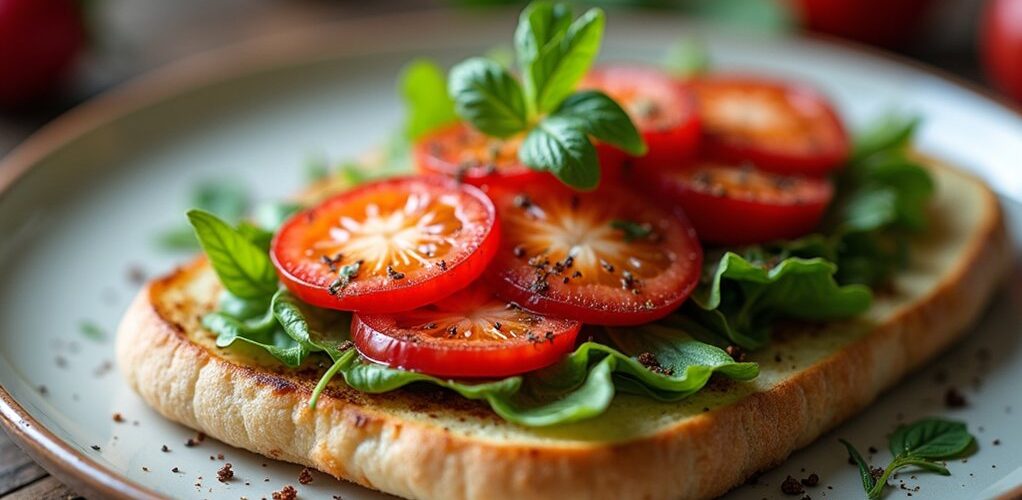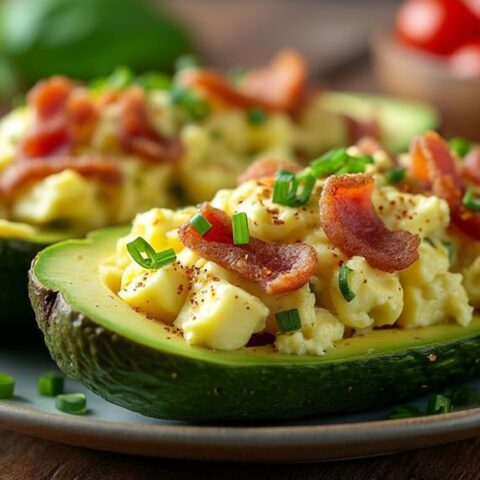
Baking powder is generally considered low-carb, containing less than one gram of carbohydrates per teaspoon due to its cornstarch component. This chemical leavening agent works through acid-base reactions to create carbon dioxide bubbles, not through carbohydrate processes. For strict keto baking, alternatives include homemade versions using baking soda and cream of tartar, or natural leavening methods like whipped egg whites. Understanding proper measurement and freshness testing helps achieve ideal results in low-carb baking.
Key Takeaways
- Baking powder contains minimal carbs, with approximately 1 gram of carbohydrates per teaspoon due to its cornstarch content.
- The chemical leavening action of baking powder works through acid-base reactions, not carbohydrate processes, making it suitable for low-carb baking.
- Low-carb baking powders without cornstarch fillers are available commercially, offering even fewer carbohydrates per serving.
- Homemade baking powder can be created by combining baking soda and cream of tartar, eliminating the need for cornstarch.
- Alternative rising agents like whipped egg whites or vinegar with baking soda can provide zero-carb leavening options.
Understanding Baking Powder's Composition and Carb Content
Baking powder's role as a leavening agent in low-carb baking has gained significant attention among health-conscious bakers. The composition of this essential ingredient primarily consists of baking soda, an acidic component like cream of tartar, and a moisture-absorbing agent such as cornstarch.
While the cornstarch does contribute a minimal amount of carbohydrate content, it's remarkably low at approximately 1 gram per teaspoon serving.
For those following low-carb recipes, understanding baking powder's minimal impact on total carbohydrates is vital. The primary leavening agents within baking powder work through chemical reactions rather than carbohydrate-based processes, making it a suitable choice for various dietary restrictions.
Since recipes typically call for small quantities, baking powder's contribution to the overall carb count remains negligible in most baked goods.
The Science Behind Chemical Leavening
Baking powder's chemical leavening action starts with the combination of an acid and base component, which creates carbon dioxide bubbles when exposed to moisture and heat.
These microscopic bubbles expand throughout the batter or dough during the baking process, creating the characteristic light and airy texture found in properly leavened baked goods.
The double-acting nature of modern baking powder guarantees peak rise through two distinct phases of bubble formation: first during mixing, and then again when heat is applied during baking.
Exploring Chemical Reactions
At the heart of chemical leavening lies a fascinating reaction between sodium bicarbonate and acid components, which creates the essential carbon dioxide gas responsible for making baked goods rise.
Understanding this chemical reaction is particularly important for low carb and gluten-free baking recipes, where traditional leavening methods may not be available.
When baking powder encounters moisture and heat, it initiates a precise sequence of events that releases carbon dioxide bubbles throughout the batter or dough.
In double-acting varieties, this process occurs in two distinct phases, ensuring peak rise during preparation and baking.
This chemical leavening reaction is crucial for achieving light, airy textures in baked goods, making it an indispensable ingredient despite its minimal carbohydrate content.
Bubble Formation Process
Tiny bubbles of carbon dioxide spring into action when moisture meets the carefully balanced mixture of acid and base components in baking powder. This chemical leavening agent initiates a remarkable transformation in low-carb baking, creating thousands of microscopic gas pockets throughout the batter.
In double-acting baking powder, this bubble formation occurs in two distinct phases. The initial reaction happens immediately when liquid ingredients are added, while the second wave of carbon dioxide release takes place during heating in the oven.
As temperatures rise, these gas bubbles expand, forcing the batter to stretch and rise. This dual-action process is essential for achieving the desired texture in baked goods, as it creates the light, airy structure that makes breads and cakes enjoyable.
Comparing Different Types of Baking Powder
Several distinct types of baking powder exist in the market today, each offering unique properties for low-carb baking applications.
Single-acting baking powder releases carbon dioxide immediately upon contact with liquid ingredients, while double-acting varieties provide two stages of leavening effect, during mixing and heating.
For those following strict low-carb diets, specialized baking powders without cornstarch fillers are available, typically containing only cream of tartar and baking soda as active ingredients.
Traditional commercial baking powders usually include cornstarch, which adds minimal carb content but may concern those monitoring their carbohydrate intake closely.
Home bakers can create their own low-carb baking powder by combining baking soda and cream of tartar, allowing complete control over ingredients and carb content while maintaining effective leavening properties.
Measuring and Using Baking Powder in Low-Carb Recipes
Understanding proper measurement techniques for baking powder stands as a fundamental aspect of successful low-carb baking. When working with this leavening agent, precise measurements prevent bitter flavors and guarantee ideal texture in low-carb recipes.
Key considerations when measuring and using baking powder:
- Always test freshness by mixing half a teaspoon with hot water to observe fizzing.
- Use exact measurements to avoid dense baked goods or bitter aftertaste.
- When substituting baking powder, combine 1/4 teaspoon baking soda with 1/2 teaspoon cream of tartar.
- Incorporate into batters gently to prevent overdevelopment of gluten.
- Remember that one teaspoon contains less than one gram of carbohydrates, making it suitable for low-carb diets.
Following these measurement guidelines helps achieve consistently light, well-textured low-carb baked goods without compromising taste or dietary goals.
Alternative Rising Agents for Keto Baking
When following a ketogenic diet, bakers can choose from several effective alternatives to traditional baking powder for achieving proper rise and texture in their creations. Natural leavening methods, such as whipped egg whites and fermented ingredients, provide mechanical and biological rising action without adding unnecessary carbohydrates to recipes. Chemical raising agents, including combinations of baking soda with acidic ingredients like cream of tartar or vinegar, offer reliable leavening power while maintaining the low-carb requirements of keto baking. Additionally, incorporating keto-friendly sweeteners, like erythritol or stevia, can enhance the flavor profile while keeping the carbohydrate count low.
Natural Leavening Methods
For those following a ketogenic lifestyle, natural leavening methods offer innovative solutions to achieve light, airy baked goods without relying on traditional baking powder.
These techniques harness the power of mechanical and chemical reactions to create volume and texture in keto baking.
- Whipped egg whites incorporate air bubbles, providing natural lift and structure
- Club soda's carbonation acts as a mechanical leavening agent
- Yogurt or buttermilk delivers moisture while activating baking soda through acidity
- Vinegar combined with baking soda creates carbon dioxide for rising action
- Sour milk or lemon juice paired with baking soda offers unique flavors
These natural alternatives not only maintain low carbohydrate content but also introduce interesting flavor profiles and textures to keto-friendly baked goods, making them versatile options for health-conscious bakers.
Chemical Raising Options
Beyond natural leavening methods, chemical raising agents offer precise control over the rising process in keto baking. For those following a low-carb lifestyle, several chemical alternatives can achieve excellent results. A popular option is homemade baking powder, combining baking soda with cream of tartar and minimal cornstarch for stability.
| Agent | Reaction Type | Best Used In |
|---|---|---|
| Baking Soda + Vinegar | Quick-acting | Quick breads |
| Baking Soda + Yogurt | Slow-acting | Cakes |
| Cream of Tartar Mix | Double-acting | Complex recipes |
When selecting chemical leavening agents, consider how they interact with acidic ingredients in your recipe. While traditional baking powder works well, creating your own mixture guarantees better control over carb content. These options, combined with mechanical leavening from whipped egg whites, provide reliable rising action while maintaining keto-friendly standards.
Best Practices for Low-Carb Baking Success
Successful low-carb baking requires careful attention to both ingredients and techniques to achieve the best results.
When using baking powder in low-carb recipes, following proper practices guarantees baked goods rise effectively and maintain a light and fluffy texture.
Key practices for ideal results include:
- Always check baking powder freshness, as expired baking powder can lead to dense, poorly risen treats.
- Measure ingredients precisely to maintain proper chemical reactions.
- Allow batter to rest after mixing for improved leavening action.
- Combine baking powder with appropriate low-carb flours for enhanced structure.
- Test recipes with different ingredient ratios to perfect the final texture.
These guidelines help bakers achieve consistent results in low-carb baking while maintaining the desired texture and rise in their finished products.
Common Pitfalls When Using Baking Powder
While mastering low-carb baking techniques sets a strong foundation, bakers should remain mindful of several common mistakes when working with baking powder. One significant error is failing to test aging baking powder's effectiveness, which can result in dense and tough baked goods that don't rise properly.
Imprecise measurement of baking powder frequently leads to texture and taste issues, while improper sifting can create uneven distribution and clumping in the final product.
Proper measurement and sifting of baking powder are crucial steps that directly impact the texture and consistency of your baked creations.
When attempting to make homemade baking powder or substitute it with baking soda, many bakers overlook the importance of maintaining proper ratios and including necessary acidic ingredients for the desired leavening effect.
These oversights can compromise the quality of low-carb baked goods and diminish their overall appeal.
Recommended Low-Carb Flour Combinations
Creating ideal low-carb baked goods requires strategic combinations of alternative flours to achieve textures and tastes similar to traditional wheat-based recipes. The most successful low-carb flour combinations leverage the unique properties of each ingredient to create excellent results.
- Blend almond flour and coconut flour in a 3:1 ratio for balanced moisture and fluffiness.
- Add ground flaxseed to enhance binding properties and structural integrity.
- Incorporate psyllium husk to improve elasticity and texture.
- Mix chia seeds with almond and coconut flour for added nutrition.
- Experiment with sunflower seed or hazelnut flour for flavor variation.
These low-carb flour combinations work together synergistically, with almond flour providing moisture and richness while coconut flour contributes essential structure through its superior absorption capabilities. Additionally, sugar substitutes like erythritol and stevia are crucial for maintaining sweetness in low-carb treats without spiking blood sugar levels.
Tips for Achieving Perfect Rise in Keto Baked Goods
Achieving the perfect rise in keto baked goods requires careful attention to both ingredients and technique, as low-carb flours present unique challenges compared to traditional wheat-based baking.
Success depends on precise measurement of baking powder and strategic use of acidic ingredients to enhance leavening action. When working with low-carb flours, allowing the batter to rest briefly before baking can greatly improve the effectiveness of rising agents.
Precise measurements and acidic ingredients are essential for proper leavening in keto baking, with resting time maximizing the rise potential.
To maintain ideal texture, bakers should mix the ingredients until just combined, preserving essential air bubbles that contribute to a lighter crumb.
The right ingredients, particularly the choice of alternative flours like almond or coconut, play a critical role in determining the final texture of your baked goods, making experimentation and careful selection essential for achieving desired results.
When selecting a sweetener for keto baking, it's important to choose keto-friendly sweeteners that are low in carbs and have a minimal impact on blood sugar to avoid disrupting ketosis.
Frequently Asked Questions
Does Baking Powder Cause Bread to Rise?
Baking powder, an essential leavening agent in baking science, causes bread to rise by releasing carbon dioxide bubbles when activated. This chemical reaction creates lift, vital for both traditional and gluten-free recipes.
Is Baking Powder Low-Carb?
Baking powder is inherently low-carb, containing minimal carbohydrates per serving. When exploring low-carb baking techniques and gluten-free options, it remains a reliable leavening agent compared to other cooking substitutes.
Does Baking Powder Make Your Food Rise?
Baking powder, an essential leavening agent in baking science, creates carbon dioxide bubbles that make dough consistency expand and rise. Various recipe variations incorporate baking powder substitutes to achieve similar rising effects.
Is Baking Powder Rich in Carbohydrates?
Baking powder has minimal carbohydrate content, making it suitable for low carb recipes. Nutritional labels typically show less than 1g per teaspoon, allowing flexibility in gluten-free options and various cooking techniques.
Conclusion
While baking powder contains minimal carbohydrates, its successful use in low-carb baking requires careful measurement and understanding of its chemical properties. By combining appropriate low-carb flour alternatives, proper leavening agents, and precise techniques, bakers can achieve excellent results in keto-friendly recipes. Whether using traditional baking powder or exploring alternative rising agents, the key lies in maintaining proper ratios and following tested methods for reliable, satisfying results.










No Comments